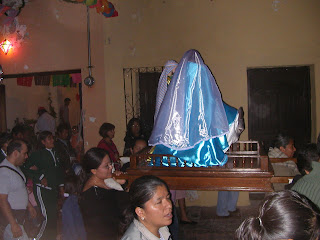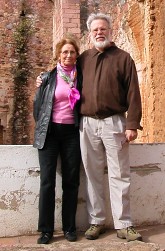
In preparation, people decorate the street in front of their houses by stretching punched paper flags, paper lanterns, and balloons etc. across the street. At 5 PM, we found out that the posada would be in our street, two hours before it was supposed to start; and no one had put up any decorations. A little past 6:00, our neighbors across the street, who do this every year and had previously asked permission to attach the decorations to our house, started to put things up. No one else on the street had even started. By 6:20, others had started; and by 7:00 when the posada folks had left La Cruz church, the street was decorated, but it was too dark to take a picture. The posada got to our house around 7:15, 15 minutes ahead of time. In the states, the decorations would have been up a day ahead, and I was getting a little nervous, being a gringo, an old grumpy gringo.

The people in the group coming up the street sing traditional songs asking the people in selected houses for posada (lodgings) because Mary is pregnant, and there is no room in the inn. The people inside sing the traditional responses asking who these beggars are, and saying that there is no room and that Mary should just keep moving on (not a direct translation). Reluctantly, the group outside laments that they have been turned down and have to keep going until they can find a house with a kindhearted owner, etc. etc. The songs are pretty complex, so there are printed versions passed out by the church if the posada is organized by a church or that you can buy in the market if you are doing it on your own.
In our barrio (neighborhood), the posada starts at La Cruz church (where Santiago and a cross miraculously appeared in the sky and the Spanish conquered Querétaro in 1531). Our barrio is thus called La Cruz. La Cruz church is also known for being where Franciscan missionary friars were trained and from where they left for indigenous towns now in the United States in the 18th century, and where Emperor Maximilian made his last stand and was then held prisoner before his execution in the 19th century.
The group in the street, often numbering from a dozen to two or three dozen get turned down at all the houses but the last. The group in the street grows as people from inside each house join the folks in the street, and the expanded group sets off for the next house previously selected to be a stopping place.

Our neighbors across the street were one of three selected in our block of Damían Carmona to “host”.

While I was trying to take pictures of the friars leading the posada songs across the street, a vendor poked at my elbow. I ignored her (I thought it was a her) and took my pictures. When I was done I turned around to the vendor and found out that he was one of my students, Christian from Niños y Niñas, selling sparklers. So I took his picture with Christiane and bought some sparklers which we gave to two little girls whose sparklers had burned out.
At the last house of a posada, the people inside sing that they have lodging and Mary can rest and eat. The people outside sing their thanks and everyone goes inside to pray and eat, meet the neighbors and break a piñata. In Mexico City and Puebla years ago, there was no praying and we went straight to the drinking and eating. I think praying is more of a Querétaro tradition.
In barrio La Cruz, they go from house to house asking for a place to stay, but at the end, instead of a party at the last house, they give all the kids a bag of goodies, called an aguinaldo, paid for by the people in that street. Last night, there were several hundred people, mostly kids, which is a lot more than at the gallos celebration or that we ever saw in Mexico City or Puebla. The people in the last house made up pretty sizable bags with stuff that people in the barrio had donated, like tangerines, peanuts, sugar cane, candy and other stuff. This reminded me of Halloween in the states, but here they have it 10 nights running. Some people donated money to buy the bags and helped to fill them. There is a whole organization to do this that is run along the lines of a mayordomia where a mayordomo is selected by the barrio or church group to run that year’s posada for each street.

In front of the last house, Christiane was greeted by a number of her students and another one of mine from Niños y Niñas who were patiently waiting in line for their aguinaldo while the friars were praying. It was a long wait, and they were very patient.
Barrio La Cruz is a little unlike many other barrios in Querétaro in another way too. After the aguinaldos are handed out people drift back home, but stop on the way to visit neighbors who have opened their houses and prepared fruit punch and food for anyone who comes by, kind of an open-house block party. It seemed that most people were handing out food and that there was a dearth of people to accept it. So we stopped at our next-door neighbors’ house and at our neighbors’ house across the street for something to eat and drink and a chat.
We learned all about our neighbors, promised to help out for next year’s posada, and found out that our house and those on either side had been lived in or used by General Carranza, an early 20th century president and his men. This must have been during the 1910 revolution known in the states more for Pancho Villa and Emiliano Zapata. You just never know what you will find out around here.
